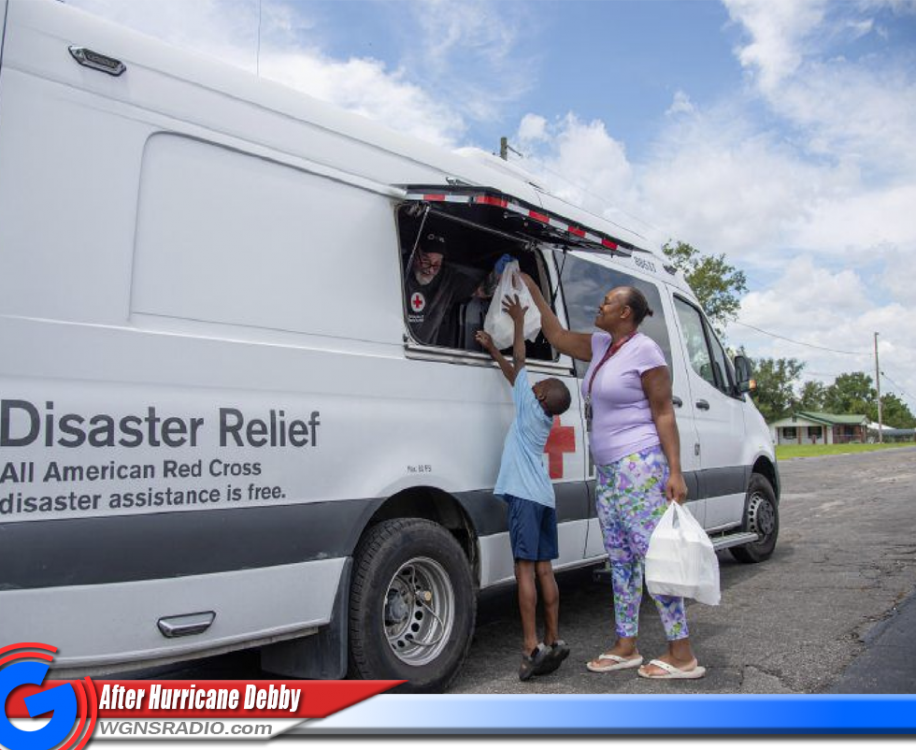As Hurricane Debby rolled through neighborhoods, with flash floods, torrential rain and alarming wind adversary speeds, American Red Cross is laser focused to support those in need.
More than 850 dedicated American Red Cross-trained volunteers from across the country are working with partners to provide safe shelter, meals and comfort for people across Florida, Georgia and the Carolinas. Tropical Storm Debby has damaged homes, left many in power outages and forced countless of people to leave their community. There are currently more than 30 volunteers from Tennessee between Georgia, Florida, South Carolina, and North Carolina assisting but this number is expected to increase.
The Red Cross is also facing a critical, national blood shortage, heightened by blood drives that have been canceled due to severe weather. Those who are able are encouraged to donate. You can sign up by calling 1-800-RED CROSS (800-733-2767) or clicking here.
There maybe an opportunity for you to volunteer at a future disaster shelter, to find out if there are any training events happening in the near future, send your name, address and phone number to the Red Cross by emailing Jonathan.Taylor@redcross.org.
In Florida: Hope Florida’s “Hope Bus” aided 300 residents in the aftermath of Hurricane Debby. Anyone who needs assistance in Florida can visit the Hope Florida website and click on “Hurricane Debby relief.” They can also call (833) GET-HOPE (438-4673).
FROM NATIONAL WEATHER SERVICE: Last week, NOAA satellites tracked Debby, a storm that impacted Florida’s Big Bend region near Steinhatchee before moving up the East Coast, causing widespread flooding and damaging winds as far north as New York state with numerous destructive tornadoes along its path. Some of the worst flash flooding occurred in rural villages and hamlets south of the Finger Lakes.
Debby began as a tropical wave that the National Hurricane Center (NHC) first began monitoring on July 26. The system eventually gained strength and was designated Tropical Depression Four near Cuba on Aug. 2. Late the following day, Debby intensified into a tropical storm in the southeastern Gulf of Mexico.
Debby strengthened into a Category 1 hurricane on the Saffir-Simpson Hurricane Wind Scale the evening of Aug. 4 before making landfall near Steinhatchee, Fla. on the morning of Aug. 5. After moving inland over northern Florida and southern Georgia, Debby slowed and moved back over the ocean off the coast of South Carolina on Aug. 6.
At about 2 a.m. EDT on Aug. 8, Debby made a second landfall near Bulls Bay, South Carolina, with sustained winds of roughly 50 mph. Later that day, it was downgraded to a tropical depression as it passed east of Charlotte, North Carolina. The storm transitioned into a post-tropical cyclone as it traveled through the Northeast and into Canada, bringing heavy rain to southern Quebec and the Maritimes before dissipating on Aug. 10.
Debby's torrential rainfall triggered widespread flash floods and river flooding across the southeastern U.S., especially from Florida to the Carolinas. By Friday, Aug. 9, more than 35 million people from South Carolina to Vermont were under flood watches or warnings. In Berkeley County, South Carolina, as much as 14 inches of rain fell last week, while Charleston recorded rainfall totals as high as 15 inches.
The storm also generated a significant storm surge along Florida’s Gulf Coast, leading to extensive damage. It's not uncommon to find trash and debris from the storm surge of hurricanes and tropical storms, but one Tampa Bay woman made a historic discovery after Debbie blew through: a World War II-era message in a bottle.
Strong winds toppled trees, damaged property, and left more than 300,000 customers without power from Florida to the Carolinas. Power outages extended to thousands more in Ohio, Pennsylvania, New York, and across New England, with Vermont particularly hard hit.
Debby also spawned numerous tornadoes across the Southeast, with at least twelve reported from North Carolina to Pennsylvania on Aug. 8 alone.
Debby was the second hurricane of the 2024 Atlantic hurricane season, following the deadly and devastating Hurricane Beryl. Debby, which formed Aug. 2, was also quite early: On average, the second Atlantic hurricane usually forms on Aug. 26, according to Colorado State University hurricane researcher Phil Klotzbach.
Additionally, Debby, which smashed into Steinhatchee, Florida on Monday, was the fourth hurricane to make landfall in Florida in August since 2000. The other three were Charley (2004), Katrina (2005) and Idalia (2023).
NOAA satellites provide vital information for forecasting hurricanes and monitoring the location, movement and intensity of storms. The GOES-16 and GOES-18 geostationary satellites continuously view the entire Atlantic and eastern/central Pacific hurricane basins to provide real-time tracking and monitoring of tropical cyclones as well as the environmental conditions that cause them to form.
By imaging a storm as often as every 30 seconds, these satellites help forecasters more easily discern the movement of cloud features and provide greater confidence in estimating the center of the storm. GOES-16 and GOES-18 also provide a detailed look at the storm properties of a hurricane, including cloud top cooling, central pressure, and convective structures as well as specific features of a hurricane’s eye, wind estimates, and lightning activity. This information is critical to estimating a storm’s intensity.
The Joint Polar Satellite System’s (JPSS) polar-orbiting satellites, Suomi-NPP and NOAA-20, capture data over each spot on Earth twice a day. They measure the state of the atmosphere by taking precise measurements of sea surface temperatures and atmospheric temperature and moisture, which are critical to securing storm forecasts several days in advance. JPSS instruments provide data that are particularly useful in helping forecasters predict a hurricane’s path 3 to 7 days out.





